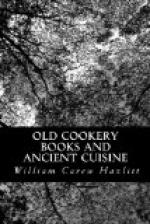In the tenth century Colloquy of Archbishop Alfric, the boy is made to say that he is too young to eat meat, but subsists on cabbages, eggs, fish, cheese, butter, beans, and other things, according to circumstances; so that a vegetable diet was perhaps commoner in those days even among the middle classes than at present. This youth, when he is asked what he drinks, replies, water, or ale if he can get it. The dish so deftly constructed by King Arthur, according to one of his numerous biographers, exhibited that wedlock of fruit with animal matter—fat and plums—which we post-Arthurians eye with a certain fastidious repugnance, but which, notwithstanding, lingered on to the Elizabethan or Jacobaean era—nay, did not make the gorge of our grandsires turn rebellious. It survives among ourselves only in the modified shape of such accessories as currant jelly and apple sauce.
But the nursery rhyme about Arthur and the bag-pudding of barley meal with raisins and meat has a documentary worth for us beyond the shadowy recital of the banquet at Caerleon, for, mutato nomine, it is the description of a favourite article of popular diet in the fifteenth and sixteenth centuries. The narrative of Mrs. Thumb and her pudding is more circumstantial than that of King Alfred and the housewife; and if the tradition is worthless, it serves us so far, that it faithfully portrays a favourite item of rustic consumption in old times. We are told that the pudding was made in a bowl, and that it was chiefly composed of the flesh and blood of a newly-killed hog, laid in batter; and then, when all was ready, the bag with all its savoury burden was put into a kettle.
As we are already on the threshold of legend and myth, we may linger there a moment to recall to memory the resemblance between the description of this piece of handiwork and that ascribed to good King Arthur, who lived in days when monarchs were their own chefs, for the Arthurian dish was also prepared in a bag, and consisted, according to the ditty, of barley-meal and fat. Soberly speaking, the two accounts belong, maybe, to something like the same epoch in the annals of gastronomy; and a large pudding was, for a vast length of time, no doubt, a prevailing piece de resistance in all frugal British households. It was the culinary forefather of toad-in-the-hole, hot-pot, Irish stew, and of that devil-dreaded Cornish pasty. The Elizabethan transmitters of these two Apician nuggets possibly antedated the popular institution of the bag-pudding; but the ancientest gastronomical records testify to the happy introduction of the frying-pan about the era when we were under Alfred’s fatherly sway. It may have even preceded the grill, just as the fork lagged behind the spoon, from which it is a seeming evolution. That no reader may doubt the fact, that Tom’s mother made the pudding, and that Tom held the candle, we refer to the old edition of this choice piece of chapman’s ware, where




